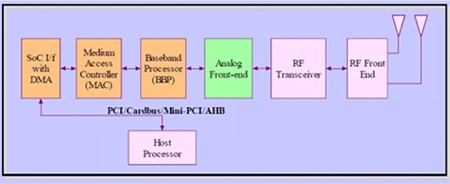Tiny low-power 802.11b/g platform supports Linux
Aug 23, 2005 — by LinuxDevices Staff — from the LinuxDevices Archive — viewsRedpine Signals has introduced what it claims to be the world's lowest power licensable 802.11b/g platform — requiring just 35.6mW during VoIP calls. The Pine1-LP Wireless LAN reference design is supported by Linux drivers, and targets mobile handsets, PDAs, digital cameras, MP3 players, gaming, and printing platforms.
Low-power could emerge as the most critical characteristic for mobile WiFi chipsets, if VoWiFi (voice-over-WiFi) phones catch on, as ABI recently predicted. The research firm suggested that VoWiFi will gain traction as WiFi becomes more ubiquitous, since it works better indoors. Currently available VoWiFi phones based on embedded Linux include the Haier N60 and the NEC 900iL. Dedicated VoWiFi phones based on Linux also available from Zultys and Siemens.
According to Redpine, a complete SDIO/SPI-based WLAN reference design based on the Pine1-LP platform draws less than 377mW during a 54Mbps FTP download, and only 35.6mW during VoIP calls. Additionally, the platform's core components, consisting of the BBP (baseband processor) and MAC (media access controller), require just 6 square mm of PCB space, the company says.

Pine1-LP Platform Block Diagram
The Pine1-LP WLAN Platform implements an end-to-end IEEE 802.11b/g reference design that provides a complete standards-compliant solution for low power mobile applications, Redpine says. It includes a BBP, MAC, analog front end, 802.11b/g RF transceiver, and power amplifier, as well as SDIO and SPI host interfaces. The SDIO interface is said to support full 54Mbps 802.11g data rates.
According to Redpine, the design's MAC supports the new 802.11i security and 802.11e QoS standards. The MAC is based on a programmable packet engine that off-loads all WLAN packet processing and TCP checksum calculations from the host, resulting in lower power and increased system performance. The platform can co-exist with popular Bluetooth chips in the 2.4GHz band, the company says.
The platform includes an “extensive suite” of firmware and driver support for Linux, Windows CE 5.0, and other popular operating systems, according to Redpine.
This article was originally published on LinuxDevices.com and has been donated to the open source community by QuinStreet Inc. Please visit LinuxToday.com for up-to-date news and articles about Linux and open source.